Gas-powered air compressors typically use gasoline or natural gas as their primary power source. They are suitable for powering multiple devices and thus, they’re usually used in worksites where many tools need compressed air. Gas-powered compressors also provide more pressure than electric ones, making them a great substitute for typical household users that do not need to run power tools. Typically, these units come with an overhead hose reel, which makes it easy to quickly change the position of the compressor and hook up different pneumatic equipment.
One of the biggest reasons why people choose gasoline-powered air compressors over electric ones is due to the former’s better power-to-weight ratio. Most portable electric air compressors generate around 5 CFM (cubic feet per minute), which is enough for inflating bicycle tires and similar low-pressure tasks, but not much else. Gasoline models, on the other hand, can generate anywhere between 6 and 20 CFM depending on their power rating. They also tend to be noisier than their electric counterparts, so many users prefer investing in-ear protection while using them.
Best 10 Gas Air Compressor Models Reviewed
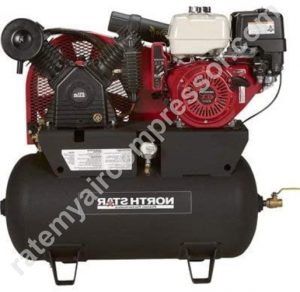
The NorthStar 459382 is a utility-class gas-powered air compressor. This Honda GX390 OHV engine air compressor has an electric start and recoil so you don’t have to worry about the cold mornings when your coil box starts giving out on you. Also equipped with a 3 Amp battery charging circuit for quick and easy starting, this machine will suit anyone’s needs in the light assembly department of their small business!
Plus, it’s got a V-style pump cylinder design that keeps the fluids warmer to deliver smoother operation and conveys superior cooling via low vibration technology (LVT). You’ll find larger crankshaft bearings than most models at 175 max PSI for all those large rotoirings or tires. And who doesn’t love greener technology? No C02 emissions! And with the NorthStar lineup, you will get an extra warranty at no additional cost!
- You won’t find a compressor with more torque than this one. It has an awesome 17:1 compression ratio and runs in a 4 cycle engine.
- You don’t have to mix gas and oil because it is an all-in-one unit, which makes it easier to get started.
- It Quieter than other models, yet works just as fast and efficiently.
- Not for heavy-duty job sites
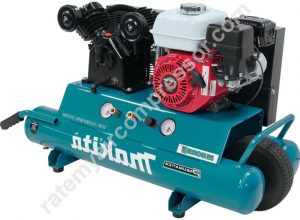
The Makita MAC5501G 12-Gallon Twin Air Compressor delivers 60 seconds of running time on the powerful Honda GX160 engine for top performance. its 10-gallon, twin tanks provide air supply to multiple nailers so you can get your work done fast. The “V” Twin Style Pump runs cooler and provides up to 12.5 CFM at 100 PSI so you can run multiple tools simultaneously without sacrificing quality air pressure. And confidence in the performance is built with a cast iron “V” twin style pump that’s engineered to run cooler with a faster recovery time for increased performance, while also being easier up on your fuel usage. With its additional 1/2″ ball valve for use as a non-slip stationary base, you can feel secure knowing that your compressor will stay in place while still getting the job done. And with its “overhead” design, maintenance is easy on this oil-lubricated pump that includes an automatic shutoff for safety purposes when the desired pressure is reached.
- Holds up to 2.5 CFM at 90 PSI
- 12-gallon twin tank, providing great air supply to multiple nailers; preventing downtime and waiting for the compressor to fill back up again.
- Comes with a 1/2″ ball valve for stationary use and provides a locking mechanism for increased user safety when in use or not in use.
- It Easy to maintain, easy to access required parts for oil changes etc.
- It Larger than most brands with a 55lbs weight.
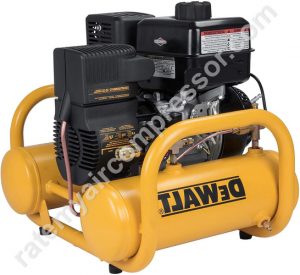
The DeWalt DXCMTA5090412 is a gas-powered air compressor with a reliable and durable engine, perfect for taking on any task. Features include dependable Briggs and Stratton XR950 OHV gas engine, 208 CC engine providing 6.9 CFM at 40 psi or 5.0 CFM at 90 psi, 1/4 in the regulator, tool, and tank pressure gauges – all of which ensure durability and longevity. With the 4-gallon tank capacity available here you won’t need to stop for long periods of time; this lightweight pontoon-style compressor ensures easy portability that isn’t too heavy to carry up your ladder either! A 3/8 in. NPT coupler makes air tool connection quick and easy, giving you the simple capability to switch between tools with ease.
- Comes with wheels for easy portability even if it can’t be moved on your own due to weight or size.
- It Perfect for small jobs including home use without overworking one tool or killing the motor because it has a very low recovery time.
- The regulator, tank pressure, and tool pressure gauges all ensure the simplicity and durability of this product.
- Not for heavy-duty jobs such as large renovation projects or construction work with multiple tools used simultaneously.
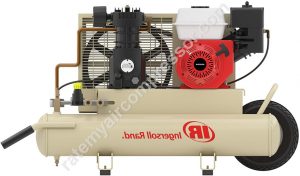
This portable, powerful air compressor is ideal for any work environment where electricity is not available. Powerful with twin 8-gallon tanks and quick disconnect couplers, this model creates enough air to run multiple tools at once. Durable cast iron construction ensures that this model will last the long haul with over 5000 hours of trouble-free use. Built-in features like an easy start gas engine, Easy Select synthetic lubricant with 2,000 hours of protection against wear and tear make every outing different yet safe even in extreme weather conditions perfect for all seasons or acres large or small for you’re pumping needs Ingersoll Rand’s SS3J5.5GH-WB Gas Powered Air Compressor can’t be beaten.
- The high CFM it provides makes it powerful enough to take on any tough jobs without worrying about slowing down or breaking down midway.
- A highly reliable engine with an Easy Select synthetic lubricant that protects the compressor against wear and tear so you don’t have to constantly worry about repairing it or replacing parts.
- 5hp engine with twin 8-gallon tanks that are air-cooled for increased battery life and durability, perfect for high temperatures.
- It Requires a maintenance schedule similar to an automobile with regular oil changes every one hundred hours used or at least once a year even if not used.
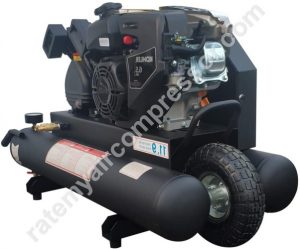
The HPV Piston Gas-Powered Air Compressor is a durable air compressor that can be used for professional tasks, as well as at the house. Simply fill it with your choice of gas, and then press the pedal to use. This one-stage pump is designed to last years thanks to its quality cast iron construction. Another safety perk? A quick-release valve allows you to depressurize this all-terrain wheelbarrow so you don’t have to bleed it from a shutoff valve during larger jobs or storage periods without losing any pressure!
Large engines operate smoothly across a wide range of loads and engine speeds, helping reduce fuel usage and maintenance costs over other models. Duramax Powered Wheelbarrows packs power into a manageable size so that you can get the job done, easily.
- Easy to use with large engines that support smooth operation across varying engine speeds and loads.
- The one-stage pump is designed for durability because of its cast iron construction which means no more constantly worrying about maintenance issues.
- Designed with a quick-release valve to ensure a safe and easy experience not just for the person using it but also for those around them.
- It’s heavy so needs two people or a lot of strength to carry it from place to place.
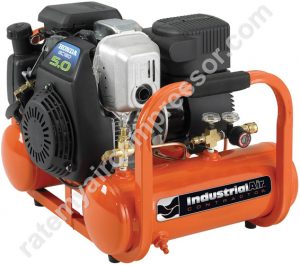
Industrial Air Contractor CTA5090412 Gas-Powered Air Compressor
It’s no laughing matter, but with a 5 HP Honda OHV/OHV premium residential gas engine, the Industrial Air Contractor 4 gal. the compressor will make you double over in laughter! With a 155 PSI max pressure, this industrial air compressor is perfect for your home and toolkit. The patented pump design features a two-piece cooling system that increases cooling efficiencies to help extend the life of your equipment. Even still, all that time on the manufacturing line has left this product totally stressed out about its future- don’t worry though because now it feels really secure after downloading our brand new ezzee app!
- A durable engine that’s guaranteed to last the long haul because of its unique two-piece cooling system designed to increase cooling efficiencies.
- Manufactured with extra features like a pressure switch, regulator, and lubrication point for easy set up without worrying about finding compatible products.
- It has to be attached directly to a power source like an outlet, which can limit its portability.
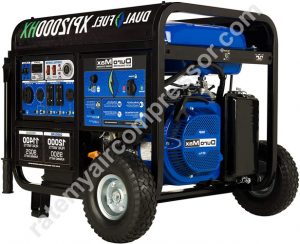
It’s hard to find power in one of those sudden summer storms where strong winds and heavy rainfall knock down electrical lines, again and again, not allowing utilities to restore the power. It just feels like it will never be restored yet you still need things like cellphones on standby, food always needs cooking, and kids want their iPads with fresh charges on them playing Minecraft all day long! If anything is going to help protect your home from these frustrating events then something as practical as a DuroMax XP12000HX is worth every penny! This generator features tons of safety features for your family including CO Alert technology that will shut down the generator if an unsafe level of carbon monoxide is detected.
- A generator that features a ton of safety features to ensure a worry-free time using it.
- Operates with a powerful 240cc OHV engine that provides reliable power for your job needs.
- Needs to be started manually unlike an electric generator which starts up instantly when you press the button.
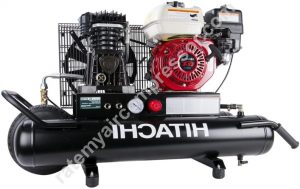
Stop replacing disposable air compressors and start investing in the Hitachi 8 Gallon Gas Air Compressor. Made with solid cast iron cylinders, this powerful machine can power through tasks for years before needing service work. Its baseplate includes an integrated control panel that protects the gauge, regulator, and plumbing while centralizing controls for easy operations. The oil level sight glass makes it easy to monitor your oils level so you never run out while operating which would damage your pump. The Hitachi 8 Gallon Gas Air Compressor also features a pneumatic throttle control that eliminates the cord typical of traditional corded models. These add-ons all lead up to increased safety and efficiency – sounds like a winning combo!
- Features a cast iron cylinder that is durable enough to last for years.
- Designed with an integrated control panel to protect the gauge, regulator, and plumbing for increased safety.
- Operates with a pneumatic throttle control so you don’t have to worry about tripping over cords or replacing them.
- You need an electrical outlet to plug it into since it doesn’t run on batteries like other hand-held models.
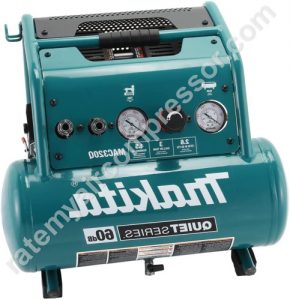
The Makita® Quiet Series 1-1/2 HP, 3 Gallon, Oil-Free, Electric Air Compressor (MAC320Q) is the best choice for using at home. Our factory made it so you could be quieter when working on an inside job, like assembling cabinets or furniture. It runs at a lower RPM than comparable models because we care about your time and money – not just about making noise. It’s powered by a 1-1/2 horsepower induction motor that can take you up to 90 PSI. The lightweight design lets you move it around the house easily while keeping product life in mind for its low RPMs. It’s made with a dual-piston pump that improves recovery time and it also has an automatic shut down feature to prevent damage from overuse.
- Features a lightweight design and can be moved around the house easily.
- Runs at a lower RPM than comparable models because we care about your time and money.
- Designed with a dual-piston pump to improve recovery time.
- Comes with an automatic shut down feature to prevent damage from overuse.
- AC or DC power is required since it doesn’t run on batteries like other handheld models.
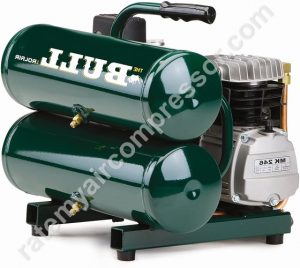
Rolaid Compressors are a good, old-fashioned American company dedicated to not only providing a product that will meet your needs but also giving you unparalleled customer service. They work hard every day at delivering a compressor that will provide you with unsurpassed performance and high energy efficiency. Rolaid offers for sale three varieties of fighting power coupled with capacities ranging from 10 cfm up to 15 cfm or 16 cfm – choose whichever is best for you! Many options are available in the way of couplers so it’s easy enough to find what you need at any given time. Let them know if there’s anything they can do for you, they’re always happy to help!
- Can run on different types of couplers so you can easily find what you need.
- Offers three varieties of fighting power coupled with capacities ranging from 10 cfm up to 15 cfM or 16 cfM.
- Comes with exceptional customer service that is always willing to help.
- It is heavy so it might be difficult to move around your garage.
What to Look For When Buying a Gas-Powered Air Compressor?
There are several things you’ll need to take into consideration when shopping for a gas-powered air compressor: tank size; engine type; pump style; circuit breaker specs; weight and dimensions.
Depending on how big your air compressor is going to be, you may have to buy either a 20-gallon or a 30-gallon tank. Obviously, bigger tanks will give you more compressed air time before they need to be refilled. They’re a good choice if you plan on powering multiple pneumatic tools with the same unit.
Most gas-powered compressors come with either 4-stroke or 2-stroke engines. The former typically runs cleaner and quieter than the latter but it also tends to cost more as well (some 4-stroke units can cost twice as much as their 2-stroke equivalents). However, 4-strokes also provide more power, allowing them to run multiple pneumatic tools without any problems.
There are two kinds of compression pumps for air compressors – piston and diaphragm. Piston units are cheaper but they’re also heavier, making them more suitable for smaller units that can only power a single tool at a time. Diaphragm units are lighter, more efficient and they tend to be quieter in operation as well. They’re the better choice if you plan on powering several devices with your compressor.
Most people wouldn’t think about it but the electrical circuit breaker is just as important as the engine or tank when it comes to determining whether or not an air compressor will work properly. To put it simply, the circuit breaker is there to protect both you and your equipment from damage in case of a power overload. Circuit breakers with lower amp ratings (like 15 amps) may trip more often but they’re also more protected against damage. Finally, try to verify that the circuit breaker specs are comparable to those used for other compressors of similar size and output.
By weight, most gas-powered air compressors range from about 40 pounds all the way up to 100 pounds or more depending on their tank volume and engine/pump type. Ultimately though, these figures don’t really matter since portable units come with wheels anyway so you can push them around as needed. As far as physical dimensions go, remember that bigger is not necessarily better. Larger compressors are costlier, use more power, need larger engine displacements, and are more difficult to transport (even with tie-down straps) compared to smaller ones.
Types of Gas Air Compressors
There are two types of gas-powered air compressors – single-stage and two-stage units.
- Single-Stage Gas Air Compressors
As their name implies, single-stage units use a single piston/cylinder to produce compressed air. On the other hand, they do not rely on valves to adjust the pressure levels; instead, the exhaust valve regulates the amount of compressed air that gets released into an attached tank at any given time. This allows users to quickly switch between different pneumatic tools and devices without having to wait for too long until they can release all of their built-up energy and resume operation again. Just like with electric models, there is also a wide range of duty ratings available in order to meet the specific power needs of any given user. These vary from one user to another, depending on factors such as what tool or device is being used, how much space is available, and so on.
- Two-Stage Gas Air Compressors
Instead of having just a single-piston/cylinder system, two-stage units have both an intake and outlet valve to adjust the pressure levels coming out of each cylinder. This allows them to produce greater ranges of compressed air than their single-stage counterparts – instead of just 5 CFM (cubic feet per minute) like most portable electric models can provide, two-stage gas-powered models can generate around 25 CFM under optimal conditions. This makes them perfect for running multiple devices simultaneously and with less lag time. However, they are also larger and heavier than single-stage units.
Portable vs Stationary Air Compressors
Before we get into specifics about gas-powered air compressors and how they work, let us define what we mean by portable and stationary air compressors.
Portable compressors are those that can be carried from one place to another. They sport smaller motors and tanks, which allow them to produce enough compressed air for a single user at a time. Portable units are typically used for trimming weeds, inflating rubber tires, airing up sports balls, and other similar tasks. In general, not all portable units can run off of gasoline – some need to be plugged into an AC power outlet before they can do anything.
Stationary air compressors come in two types – vertical/stand-up and horizontal/floor-standing models. Both of these work by using a belt or a direct drive arrangement to transmit power from the motor shaft to the compressor’s pistons via the crankshaft. This is the same way car engines function, giving stationary compressors enough power to run multiple tools simultaneously.
The two types of stationary air compressors also have different mounting options – floor-standing models can be bolted down and thus, stay in one place all the time. They’re best-suited for workshops and other similar places where they can’t be easily moved around. Vertical units, on the other hand, come with wheels, making it easy to move them from one place to another as needed.
FAQs
Conclusion
Gas air compressors are suitable for powering a wide variety of tools at your Jobsite. They may be more expensive than electric models but they’re also much more powerful and can last longer without needing repairs. In fact, gas-powered compressors are the preferred choice among professional tool users since they can operate continuously without overheating or shutting off due to low tank volume. If you need a compressor for your business, there’s no more suitable choice than a gas-powered model.
However, if you plan on getting one of these products for personal use at home or some other location, shop around first to see how much power and tank volume you’ll actually need. A smaller compressor with a lower weight capacity is often the best option since it will be easier to transport and store compared to larger/more powerful types that have higher costs as well. Just remember that going too small may reduce the convenience factor of using this type of product in general so make sure to read through our air compressor reviews before making your final decision.